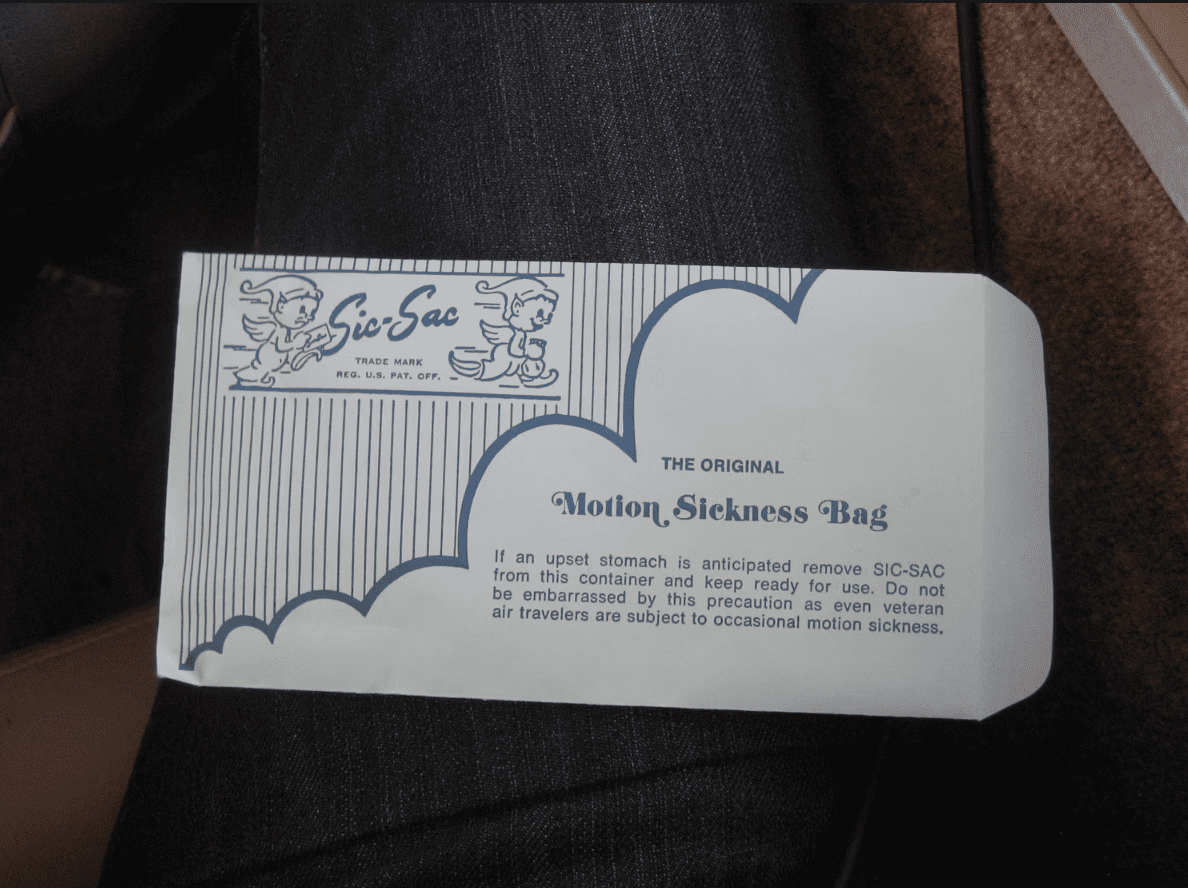Air Sickness Bags: Why We See Them Less Frequently Nowadays
The interesting history behind a simple plastic bag in case you get airsick…

Here’s a history on air sickness bags and why you do not see the unique plastic bags so much when you fly commercially anymore.
What is air sickness?
First, one should define air sickness. Air sickness is, according to the US pharmacist Walgreen’s:
“Air sickness occurs when there is a conflict between your senses and the parts of your body that assist in balance, including the inner ear, eyes, and sensory nerves. In the case of flying on a plane, your inner ear and sensory nerves can feel the movement of the plane while your eyes see the stillness inside the cabin and may not register the movement. This conflict between senses is the cause of air sickness.”
Walgreen’s says that antihistamines can prevent or treat symptoms; more robust options are available. One option is Prescription-only scopolamine transdermal patch, but please consult with your medical provider before asking for a prescription.
There are also some non-pharmaceutical options available to address air sickness. One option is to have a seat towards the middle of the cabin to reduce the shakes in flight – and also have a window seat so you can focus on the horizon to minimize nausea. Another option is to mind your diet and stress levels. Avoiding alcohol and reading are other options some recommend. Having a ginger ale – a non-caffeinated beverage most airlines carry – can also be of service to combat nausea.
But there’s also some sage advice from Canada’s Weather Network one should watch if you’re still worried about air sickness:
Before we move ahead into discussing air sickness bags, one should note that Simple Flying recently profiled how early warning of turbulence is improving. This means pilots can more easily avoid the top inducer of air sickness – turbulence.
Air sickness bags were intended for use in…

Air sickness bags are plastic and paper bags, and well… plastic bags were invented by Gilmore Schjeldahl. According to the University of North Dakota that holds his writings, the bags are descendants of Mylar polymer bags meant for pickles and atmospheric balloons made by Schjeldahl’s machines. The patent itself says
Our novel bag is intended for use in storing of foods etc. in refrigerators, deep freezers, and the like, where it is important that the contents be preserved for an appreciable length of time without loss of moisture or freshness. t is sometimes desired to use only a part of the contents at one time and to save the remainder thereof for use at a later date.
The bags were neither meant for storing vomit nor for commercial artwork on the outside. Nonetheless, the bags were deemed trustworthy for keeping vomit – a product of air sickness – contained without odor or spillage.
According to Slate, Northwest Airlines – now absorbed by Delta Air Lines – would be the first user of such bags. The bag’s fame would bother Gilmore and overshadow his many other accomplishments, like building balloon satellites for Project Echo. These balloon satellites would reflect radio signals around the Earth and start a new era of telecommunications.

Yes, Spirit Airlines – America’s leading ultra-low-cost carrier – sold advertising space on its air sickness bags at one point. According to a March 11, 2014 report in Skift, Spirit said that $30,000 would purchase ads on 150,000 air sickness bags per quarter. Remember: The cost to fly a human is not related to how low the fare is, so those costs need to be recovered somehow.
A year later, Joseph Rose of The Oregonian flew on Spirit and found no barf bag for his airsick daughter. Rose reached out to a Spirit spokesperson, who responded that restocking the bags would be too costly and that he should have paged a flight attendant. Rose’s response was,
“I decided the missing airsickness bags took cost-cutting in the unfriendly skies too far. No-frills shouldn’t mean no-dignity. … Perhaps Spirit should offer another add-on to customers: A little humanity. So, how much should that cost?”
One can only be left to hope the likely upcoming acquisition by JetBlue will improve the passenger experience.

Air sickness bags as collectibles
But some see air sickness bags as easy collectibles. There is even an Air Sickness Bag Virtual Museum if you wish to see many varying air sickness bags – and not just airlines’ air sickness bags but also political conventions and more.
For curator Steven J. Silberberg, collecting air sickness bags is his call to uniqueness, according to the October 21-28 1999 Philadelphia Citypaper. According to the January 3, 2008, Boston Globe, Silberberg likes collecting the artwork on the bags and has a Google Alert set to “air sickness bag.” Perhaps the way some of us have Google Alerts assigned to favorite aircraft like the 737 MAX, A380, Dash 8-400, or in the case of this author, the Boeing EA-18G Growler. So hi Steven!
According to the Guinness Book of World Records, the most extensive collection of such bags goes to Niek Vermeulen of The Netherlands, with 6,290 airline sickness bags from 1,191 different airlines. RecordHolders.org reports Niek started this on a dare and now even has a Space Shuttle Columbia air sickness bag as part of his collection. Niek also has collected 1,200 airline playing cards.
Conclusion
Air sickness may occur much less often but is still accurate for the flying public. Air sickness bags were intended to be simple tools for dignity if you have to vomit mid-flight and can’t get to the toilet in time rather than collector’s items that marketing can be sold on. As the need for air-safety bags decreases, it’s hard to justify making new ones out of plastic.
Source: Simple Flying

Warning: Illegal string offset 'cookies' in /home/u623323914/domains/eng.bayviet.com.vn/public_html/wp-includes/comment-template.php on line 2564